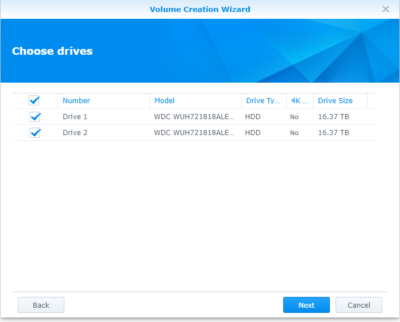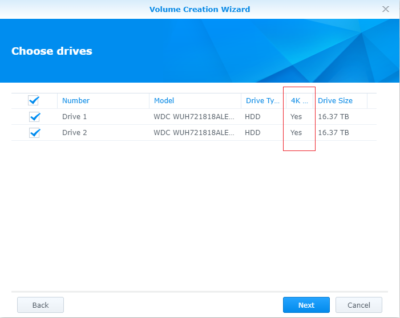A few years ago I started using 4Kn drives in my storage (Open-E and Synology NAS). You had to decide for a 4Kn (native) drive or a 512-byte drive when buying it.
Now, a few years later, companies like Western Digital (HGST) and Seagate come with ‘Advanced Format’ drives, it’s one drive which you can use in 512-byte mode or 4Kn mode. I recently bought two Western Digital (HGST) Ultrastar DC HC550 (18TB) drives and had some struggles with them to use them in my Synology NAS as 4Kn drives. See how I fixed it..
I inserted the drives in my Synology (DS1817+) and when I wanted to create a new Volume it showed me the following:
So I opened an SSH session to the Synology and did an fdisk --list which showed me it was having a sectors of 512 bytes instead of 4096 bytes:

Even after connecting the disk to my Laptop using an Aptgtek USB to SATA converter and formatting it using Windows 10 with a different sector size, it still showed as non 4Kn drive in the Synology.
Then I used the tool: “Hugo” which is a Western Digital proprietary tool and can be downloaded here. (See at below for mirror download links!)
I used version 7.0.3 for Windows and used the following commands:
To detect the disk:
C:\Program Files\WDC\HUGO\bin>hugo s --device
Manuf. Model Serial Interface Capacity Type Firmware
-----------------------------------------------------------------------------------------------------------
1) SanDisk X600 1839E0805995 SATA 256 GB SSD X6114012
Device handles: \\.\PhysicalDrive0
2) HGST WUH721818ALE6L4 3WG7MU9K SATA 18000 GB HDD PCGNW120
Device handles: \\.\PhysicalDrive2
To format the disk:
C:\Program Files\WDC\HUGO\bin>hugo format -g \\.\PhysicalDrive2 -b 4096 --fastformat -n max
******************************** WARNING **********************************
The Format command will result in loss of data on the specified device.
This device might be your boot device and it won't be protected.
******************************** WARNING **********************************
Are you sure you want to Format this device? (Y/N) Y
Format device on 1 Device(s)...
Failed: Format command Failed on device 3WG7MU9K.
Device will not be formatted.
Even though it fails to format the disk, it does write the sector size / partition table to it and when you insert the drive in you Synology now, it will show you 4096 byte sector size and you can now create your 4Kn volume!


Note: I first used Hugo v7.2.6 without success, then when I used Hugo v7.0.3 it notified me of using the -n max parameter, which did the trick.
UPDATE (18-02-2021): Since all download links to Hugo 7.0.3 seem to be removed, download it here: HUGO-7.0.3.win64
UPDATE (01-05-2023): See download links for Hugo 7.4.5 (Windows, Linux, BSD) here: https://archive.org/download/hugo-7.4.5
Would Hugo work on Segate drives as well? Can I run it on Linux Mint?
Have 4x 12TB SHR array that I wanted to add some drives. Bought new Seagate X18, and surprise-surprise – Synology sees them as 4kn drives and will not add to my array.
Now I have a decision to make – should I rebuild everything to 4kn, or downgrade new drives to 512?
Current 4 drives are ST12000NM0127
Also have one ST12000NM003G that is compatible with old array.
2 new drives are ST12000NM021J
Here is Hugo 7.5.1 (Win)
https://files.hddguru.com/download/Software/HGST/
Are there any Toshiba enterprises hard drives that support advanced formatting?
i contacted WD support to get the latest copy of HUGO (7.4.5) to convert my HC550s
my ultimate target is a DS720+, but i did the conversion in an ancient Dell desktop running w10 with an integrated sata controller
I was concerned i needed to deal with the PWDIS issue; but wasn’t a problem for me
As people have said; you need to run hugo as administrator command prompt
First; i verified hugo could see the drive/sector size (i blanked out the serial number for some odd reason when i posted this)
C:\Program Files\WDC\HUGO\bin>hugo show –device -b
Manuf. Model Serial Interface Capacity Type Firmware
—————————————————————————————————-
1) SSDSC2BB480G6 BTWA517405LV480FGN SATA 480 GB SSD G2010150
Block Size: 512 Native Block Size: 4096
Device handles: \\.\PhysicalDrive0
2) HGST WUH721816ALE6L4 xxxxxxxx SATA 16000 GB HDD PCGNW232
Block Size: 512 Native Block Size: 4096
Device handles: \\.\PhysicalDrive1
then i ran the fast format (which doesn’t really format; just changed the sector size)
Note that looking around; i DID NOT use the -n parameter
C:\Program Files\WDC\HUGO\bin>hugo format -g \\.\PhysicalDrive1 -b 4096 –fastformat
******************************** WARNING **********************************
The Format command will result in loss of data on the specified device.
This device might be your boot device and it won’t be protected.
******************************** WARNING **********************************
Are you sure you want to Format this device? (Y/N) y
Format device on 1 Device(s)…
i got a full screen confirmation dialog, hit NL; and the command returned a few seconds later
afterwards….
C:\Program Files\WDC\HUGO\bin>hugo show –device -b
Manuf. Model Serial Interface Capacity Type Firmware
—————————————————————————————————-
1) SSDSC2BB480G6 BTWA517405LV480FGN SATA 480 GB SSD G2010150
Block Size: 512 Native Block Size: 4096
Device handles: \\.\PhysicalDrive0
2) HGST WUH721816ALE6L4 xxxxxxxx SATA 16000 GB HDD PCGNW232
Block Size: 4096 Native Block Size: 4096
Device handles: \\.\PhysicalDrive1
I don’t yet have my 720+; but i’m assuming at this point it will see the 4k block size and do the correct thing
Hi
You can find HUGO for Windows, Linux, and firmware via FTP on atxlab.ddns.net
So far no luck to have my HC550 18TB to be recognized as 4K.
could you precise which brand / model of USB to SATA controller you are using ?
I found no trace on internet of Aptgtek brand.
Best Regards,
John
For a direct comparison between 512e and 4kn drives:
https://forums.servethehome.com/index.php?threads/comparison-512e-versus-4kn.34323/
If someone has HUGO for Linux, please share as I am unable to find it anywhere. Thanks!
@Roel
WD support have been useless. They asked me to format with serial number, which I already tried, and asked for screenshots of commands and errors that I had already sent to them.
I returned the 512e disks and back-ordered some 4Kn native ones. Lesson learnt.
@Roel
Yes, I used the HUGO tool as per your instructions on this page. I found a newer version of HUGO (7.3.2), installed it and ran the procedure again.
I got the same error message:
“Failed: Format command Failed on device XXXXXXXX
Device will not be formatted”
Upon reinsertion back in the the Synology NAS the storage pool that I’d created was still intact and the ‘4K native HDD’ column in the storage pool creation wizard still says ‘no’.
This is the page with the link for the HUGO 7.3.2 download:
https://forums.servethehome.com/index.php?threads/please-help-convert-hgst-he10-and-he12-to-4kn.27668/
Or it can be found directly here:
https://www.mediafire.com/file/zhfnbttx181hg68/hugo-7.3.2-WIN_and_Linux.zip/file
WD support still haven’t come back to me. I’ll report the result back here if and when they do.
I also note that it’s not possible to register the HGST disks on the product registration website, which is a bit annoying as I won’t be notified of any firmware updates or product information.
@Darren Foley; Very strange. Did you use the HUGO tool, what did that say?
Just tried this with a couple of HGST HC510 drives (HUH721010ALE604/0F27606 10TB drive without success. The Synology DS920+ still sees them as non-4K native.
Have raised a support case with WD.
@walter beyeler.
The 4kn disk writes blocks of 4096k on its platters but reports to the operating system it is 512kk seconds ctor disk. This means Windows will divide all data into chunks of 512 and give this to the disk. The disk than converts these chunks to 4096. This is a extra step which takes time and takes place within the harddisk. So yes there is benefit to convert the disk to 4k native reporting instead of 512k reporting to the OS. The reason is some systems and software can only underatand 512 chunks of data. But on modern systems this is not a issue.
I have a 8TB wd elements external drive. I don’t know if I can use Hugo to get ghe 4kn instead of 512e. Will Hugo warn me if yhe disk is not able to change to 4kn?
Many say the 8TB wd elements has a whitelabel HGST.
current drives are starting to be 4k block sizes under the covers – but the drive can either be configured to show that 4096-byte sector size to the host/controller (4kn, or 4k native mode), or essentially lie and say it’s a 512-byte block, which gives you the 512e (emulated) mode. The downsize to 512e is since date is actually written to the drive in 4096-byte chunks, if the host writes 512 bytes, the drives has to go fetch the 4096 bytes that were already on the drive, change just the 512 bytes the host wants changed, and write the 4096 bytes out again. This whole process enables the drive to work with a large amount of equipment that is not (and perhaps may never be), 4k-compatible, but it achieves that compatibility through a method that works, but can have a large overhead on writes.
To answer ‘why 4k’, it means that 1 sector on your harddisk is 4096 bytes, instead of the traditional 512 bytes. This results in a (small) performance advantage, and makes it possible to have better error correction (see https://en.wikipedia.org/wiki/Advanced_Format). Note that the number of bytes on your harddisk per sector (512 vs 4096) has nothing to do with the number of pixels (3840 x 2160, which is called “4k” resolution) on your screen.
Thanks for writing this article, ordered sata to usb connector to give this a try.
Thank you very much!
I had the opposite problem: the old Dell р310 controller did not see the new HGST 4kn disks. Switching (formatting :-)) these disks to a cluster size of 512 solve the problem.
For those of you that are writing that do not understand ‘why 4k’ , a lot of NASs and home servers (aside from a NAS sys) are being used for media today that plays high-end movies. 4k drives are designed for 4k UHD video such as the ones you would play on a 75″ flatpanel wall TV.
Even those of us, myself included, who do not use 4K TV’s these drives help future-proof media players for the next 5-6 years beofre the next hard disk technology is coming out which will be 8k drives.
So to answer the question briefly, many modern NAS’ such as my Synology NAS today allow 4Kn disks to be used in a storage pool, which is what I will upgrade to soon. Because, because its compatible with 4k UHD videos for my storage for playback.I already own 4, perhaps 5 UHD movies.
I have updated the post with a download link to Hugo 7.0.3.
Hi,
Great article. I followed it to the dot on HGST He10 HUH721010ALE600 10TB drive but it still stays as 512e. I used HUGO version 7.3.2 as 7.0.3 is now where to be found.
I searched everywhere for 7.0.3 and all the download links are removed.
I would really appreciate if you can share it at whatever location you prefer like dropbox, google drive etc.
Thanks
AM
Could you please tell us why you want to change the sector size?
Do you expect any speed gain? Or minimize space waste?
Would be nice if you could put some download links to Hugo software since the tutorial is nice.
What would be the real world benefit to use 4K instead of 512-byte?